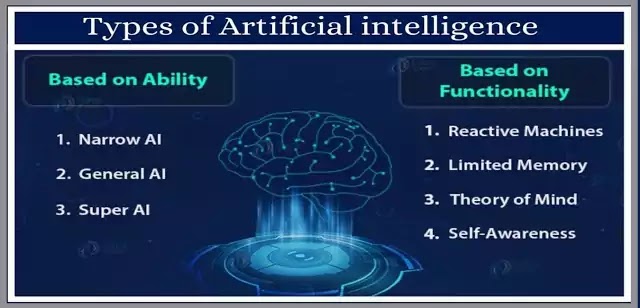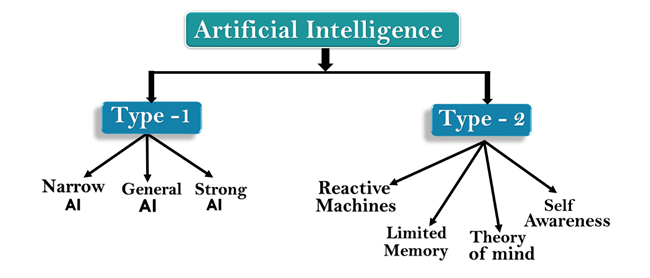Types of Artificial Intelligence (AI)– Data analytics requires a wide range of abilities. But if we had to choose only one, pattern recognition would be it. Of course, humans are good at this because our brains properly design for the job. But what if we could accelerate this? What if ultra-rapid, super-intelligent machines could identify complicated patterns in a fraction of the time it currently takes humans (days or years)?
You’ll understand what we’re talking about if you’ve seen movies like Her or Ex Machine (AI). While the kinds of AI shown in science fiction films are very different from what we now have in reality, this may not always be the case. We currently employ various AI techniques; it’s only that its usage is so common that we hardly think about it.
The field of artificial intelligence is still developing. However, devoted data scientists have developed terminology to explain the various types of AI that already exist and that may emerge in the future in light of this.
What is artificial intelligence?
OK, let’s start with a little introduction to artificial intelligence. You’ve probably seen the phrase used, but what is artificial intelligence? In computer science, we define artificial intelligence as computer programmes that can learn independently, even though this complex topic has numerous conflicting definitions.
In general, “artificial intelligence” also refers to the theoretical investigation and creation of computer programmes and algorithms capable of self-learning. Artificial intelligence (AI) is the term used to describe computers that do jobs that humans in data science traditionally do. It covers image identification, natural language processing, translation, predictive analytics, and other decision-making techniques.
Although it is a young subject, artificial intelligence is essential to many others, including data analytics and data science. Algorithms that learn from data to solve problems include deep learning and machine learning, two subgroups of artificial intelligence. If you want to learn more, this post discusses the distinctions between machine learning and deep learning.
What various Types of Artificial Intelligence (AI) are there?
Since AI aims to replicate (or at least approximate) human intellect, the pinnacle of AI research is to create a machine that can think, learn, and express emotions just like a person. It would be the height of accomplishment for many people. Others find it to be a terrible thought. Whatever the case, it’s helpful to know that top minds have been thinking about this potential issue for decades, even though nobody is completely discounting the possibility that artificial intelligence could become autonomous and irreversible (an outcome draconic ally referred to as the technological singularity).
Two primary AI classification systems have developed due to reasonably careful consideration. These two systems contrast the intelligence of humans with various fictitious forms of AI.
The first classification scheme for artificial intelligence bases its definition on its functionality (i.e. what it can do.) We’ll refer to this as the functional classification scheme. There are four different categories in it:
- reactive machines
- limited memory
- Theory of mind
- Self-awareness

Based on its capacity, the second classification scheme for AI defines artificial intelligence (i.e. its ability to generate a given outcome.) It is the capability classification system. There are three major categories in this method (which is more frequent use in the tech industry):
- Artificial Limited Intelligence (ANI)
- Artificial General Intelligence (AGI)
- Artificial Super Intelligence (ASI)
First, let’s examine the Types of Artificial Intelligence (AI) according to their capabilities.

1. Narrow AI
With a narrow focus, AI has Today, machine intelligence is all around us and is a subset of narrow AI. Siri from Apple and Watson from IBM are two examples of limited AI.
As it only functions inside a specific and pre-established set of parameters, limitations, and situations, narrow AI often refers to as weak AI. Use cases include Netflix recommendations, product recommendations on e-commerce sites, autonomous vehicles, and speech and image recognition, which fall under the narrow AI category.
2. Reactive machines
According to the functional classification scheme, the reactive machine is the most basic (and traditional) type of AI. Any form of memory is absent in reactive devices. Therefore, they cannot acquire new skills or modify their problem-solving method due to experience. Instead, reactive robots merely intend to respond to inputs by a strict set of algorithms pre-programmed by a person.
Reactive machines always generate the same result from the same input. Despite being somewhat constrained, as a result, reactive machines are nonetheless quite helpful because they are very good at carrying out particular jobs. They are widely utilised now as a result.
What are a few illustrations of reactive machines?
The most well-known example of a reactive machine is Deep Blue, a chess-playing supercomputer developed by IBM in the 1980s. In 1996, Deep Blue defeated Russian Grandmaster Garry Kasparov at chess. Although Deep Blue is a well-known example of a reactive machine, the technology underlies it in use for a long time.
Email spam filters, Netflix and Amazon’s recommendation algorithms, and other modern reactive computers are examples. These algorithms always suggest the same series (or books or items) in response to a specific input. So, for example, if you watch Friends on Netflix, the algorithm knows to propose other sitcoms. So although Deep Blue caused quite a stir when it first appeared, we hardly even notice when it does so now.
3. Limited memory
Limited memory AI falls under the second category of our functionality classification scheme. Little memory AI can store data and learn from it to enhance accuracy and adjust its approach in addition to the reactive machine’s capabilities. A reactive machine is less advanced than a restricted memory AI in this way. It operates more as the human brain does.
Like the human brain, AI with limited memory builds reference frameworks from previously collected data. Little memory AI is not actually “thinking,” though. Thus it is not like the human brain. Instead, it program to react to various inputs and outputs. But this does not lessen the strength of AI with limited memory. It can do complex calculations much faster than the human brain (as demonstrated by DeepMind’s AlphaGo).
Fundamentally, advanced predictive analytics by AI with limited memory. It frequently employs data science because of this. Today’s world extensively uses low-memory AI, just like reactive machines.
4. Theory of mind
Theory of mind is the third division in our functional classification scheme. Unfortunately, no AI is currently capable of proving the theory of mind. Watch this space, though, since a study in this area is ongoing.
What precisely is a theory of mind? And why is it crucial to AI? The idea of mind commonly referred to as “internal simulation,” is the capacity of people to imagine themselves in another person’s position. It helps you comprehend how a person’s social or emotional state influences their ideas and behaviours (a process known as “hot cognition”), probably without you ever realising it. Human children naturally acquire this skill by the time they are four years old, but it is a considerably more complicated process for machines, who aren’t quite there yet.
5. Self-awareness
We classify functionality into four categories, with self-aware AI being the last and final category. Of course, this artificial intelligence is just speculative at the moment. Theoretically, though, it would operate just like a human.
What may this seem like, intelligent? A self-aware AI would have its own emotions, thoughts, and belief systems in addition to being able to read and react to human emotions according to the theory of mind. You know so well that distinct inner feeling of “you”? The difference between self-aware AI and the others on our list would be this.
Shortly said, while artificial intelligence frequently discusses, self-aware AI would transcend this and enter the field of artificial consciousness. All those people’s sci-fi movies are about.
6. Generally, Artificial Intelligence
An AI version known as general AI can carry out any intellectual work with efficiency comparable to that of a human. AI’s goal is to design a system that can think for itself, as humans can. Research on general AI is ongoing, and efforts to create machines with improved cognitive capacities.
7. Super Artificial Intelligence
Super AI is an AI version that outperforms human intellect and can handle tasks better than humans. A machine with super AI can think, reason, solve a riddle, make decisions, learn, and communicate independently. Super AI, while currently just a theoretical idea, is what AI will look like super AI.
Conclusion:
Enterprises increasingly rely on AI to make essential choices as it solidifies its grip on every facet of the business. AI has spread like a virus thanks to its use in driving innovative business practices, improving customer experiences, and boosting company profits. This transition to AI is now feasible due to the accessibility of AI, ML, deep learning, and neural networks for small- and medium-sized businesses.
Furthermore, in the years to come, Types of Artificial Intelligence (AI) humans and machines could collaborate, refining cognitive skills and capacities while increasing total productivity, debunking the myth that AI will replace people in all professional roles.
Also read: What Is Artificial Intelligence AI? And How does it work








GIPHY App Key not set. Please check settings